
To be listed on the haciendadelalamo TODAY MAP please call +34 968 018 268.
A history of Mazarron
The story of Mazarrón runs from pre-history to residential tourism
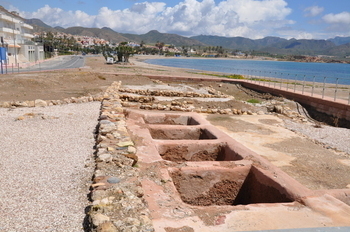
The history of Mazarrón runs from prehistoric cave-dwellers, through the Phoenicians who made an important mark on these shores (as witnessed by the ships whose remains have been discovered in the port) and the Romans, part of whose maritime trade was organized from the area, right through to the modern-day immigrants who bring their own additions and contributions to the town and its surroundings.
During the age of the Moorish invasions, the inhabitants of Mazarrón alternated between the problems of simple existence and the more drastic realities of armed struggle, due to the very real danger of the Berber pirates and the dangers they brought with them.
The founding of Mazarrón as an independent "villa" in 1572 was a major turning point in the municipality's history, although for many years it continued to owe its prosperity to the twin pursuits of mining and fishing.
The story begins, though, with the evidence of prehistoric settlements in the area. Prehistoric Man was attracted to the zone by the rich resources in terms of flora and fauna, and geographical features which made it easy for them to shelter from the perils of everyday life.
Mazarrón in the Paleolithic and Neolithic (Old and New Stone Ages)
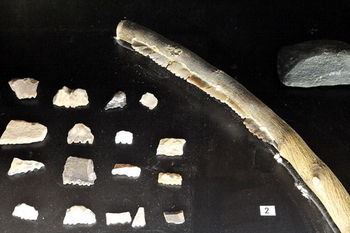 Paleolithic broadly 1 million BC to 6000 BC, Neolithic broadly 5300 BC to 3100 BC
Paleolithic broadly 1 million BC to 6000 BC, Neolithic broadly 5300 BC to 3100 BC
The oldest findings related to human inahbitants in Mazarrón have been dated to the Middle and Later Paleolithic, and various finds have been made at the sites known as Cueva Pernera, Los Tollos, La Peñica and Las Palomas, which are close to the Cabezo del Faro (where the lighthouse now stands).
Most of the findings are tools such as flint blades, scrapers, files and hammers. The remains of some of the first prehistoric ritual burial sites of the area have also been found, and at the end of the Ice Age and the beginning of the inter-glacial period the first organized prehistoric societies began to take shape.
Mankind led a fundamentally hunter-gatherer existence at this time, but the gradual tendency was towards settlement. While the making of stone tools was being perfected the first ceramics also appeared, and the first megalithic burial sites were constructed (in the shape of menhirs, dolmens and stone circles). The most important sites in Mazarrón related to this period are the caves at El Palomarico and the Caballo cave.
Mazarrón The Metal Age: Traces of the Evolution of Man
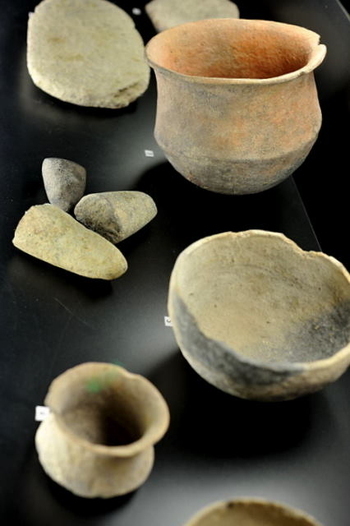 3000BC to 1000BC
3000BC to 1000BC
One of the greatest and most important revolutions in the history of Mankind was the Metal Age, which includes the Copper, Bronze and Iron Ages. This is generally held to have lasted from about 3000 BC to the first millennium BC, and in Spain the period is marked by the arrival of large numbers of people from the Eastern Mediterranean and the development of primitive metallurgy, or metal-working.
During this period characteristic elements of the area's culture developed, including the appearance of villages. These early villages and towns and the new social relationships within them gave rise to tensions and conflicts between different settlements, and early systems of urban fortification were constructed.
In the Sierra de las Moreras are the remains of the prehistoric settlement of the Cabezo del Plomo, the hill behind modern-day Bolnuevo. The settlement was at its most important in the Bronze Age although there is evidence that had existed previously, and part of its structure is still visible today. The site is representative of its times and shows clear evidence of fortification (the population was surrounded by a wall with interior bastions) as well as the remains of the necropolis, or burial ground. The dwellings themselves were round or oval, and built of stone. Early ceramics and a multitude of flint tools have also been found here, and it is considered one of the most important sites of its kind in the Region of Murcia.
There is also evidence of the Argaric culture (around 1700-1500 BC) in areas such as Ifre, La Ciñuela, Percheles, Cabezo Negro and Calnegre. This can be seen in innovations such as curved cups and glazed pots with decorative motifs featuring bone, metals and marine designs such as shells. The Late Bronze Age merges with the Iron Age, when the area of Mazarrón was first colonized by new arrivals to the coastline, who made their own impression on the land, its people and its culture.
The Men Who Came From The Sea: Phoenicians and Carthaginians
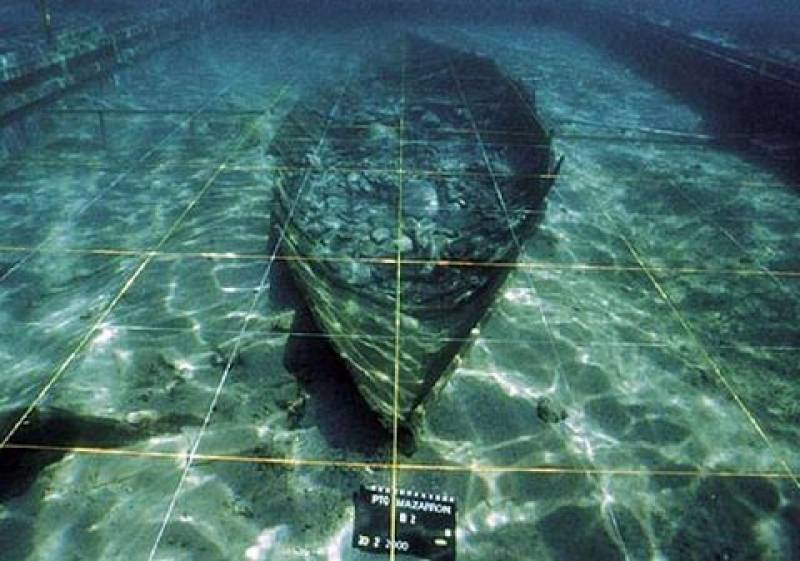 The presence of the Phoenicians in Mazarrón is highly significant. The wrecks of two Phoenician ships have been found on the beaches of Mazarrón (at La Isla and Los Gavilanes), and these are among the most important Phoenician remains found in Mediterranean waters. The remains of Mazarrón 1 and a reproduction of Mazarrón 2 are on show at the ARQUA Museum in Cartagena.
The presence of the Phoenicians in Mazarrón is highly significant. The wrecks of two Phoenician ships have been found on the beaches of Mazarrón (at La Isla and Los Gavilanes), and these are among the most important Phoenician remains found in Mediterranean waters. The remains of Mazarrón 1 and a reproduction of Mazarrón 2 are on show at the ARQUA Museum in Cartagena.
The Phoenicians first arrived in the 9th century BC, attracted by the potential wealth offered by the area's mineral wealth. This is one of the bases for Mazarrón's development throughout its history, consisting mainly of lead-based substances, and it was complemented by the salting industry which grew up alongside the local fishing fleet. The Phoenicians were the first to exploit the mining possibilities of the area, although there is no evidence to suggest that they founded any long-lasting settlement here.
The Phoenicians were merchant traders, working throughout the Mediterranean basin, and made important advances in the design and construction of ships as they widened the extent of their territorial influence, driven by commercial ambition. The Greeks had less influence than the Phoenicians, and we have little evidence of their presence in the municipality, but even so, the trading routes and networks created by both peoples throughout the Mediterranean included Mazarrón, and helped to shape Iberian culture of the south and east of the peninsula.
Certainly minerals and salt fish products were traded from Mazarrón, and traces of both were recovered from the sunken vessels found in Mazarrón.
Another group to descend upon the shores of Mazarrón in ancient times were the Carthaginians. Their most important city in the Iberian Peninsula, Qart-Hadast (Cartagena), was practically next door, but there is little evidence of other Carthaginian settlements in the area of Mazarrón. It seems that the Carthaginians passed through Mazarrón without ever establishing a permanent presence in the municipality.
The Romans in Mazarrón and garum sauce
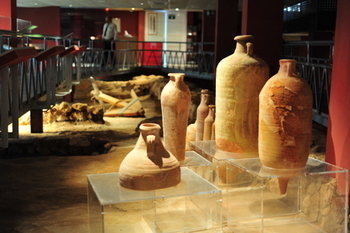 The Romans, on the other hand, did establish themselves here, naming their settlement "Ficaria". There is evidence that the mines again grew in importance under the Romans, and a large number of objects and even homes of Roman origin have been found (see the villa of El Alamillo). Romanization in the area was rapid and largely complete.
The Romans, on the other hand, did establish themselves here, naming their settlement "Ficaria". There is evidence that the mines again grew in importance under the Romans, and a large number of objects and even homes of Roman origin have been found (see the villa of El Alamillo). Romanization in the area was rapid and largely complete.
In the 1970s a Roman milestone was found near the Convent of "La Purísima", showing the distance in miles from the Via Augusta (one of the main Roman communications and trade routes running from Cádiz to the Pyrenees along the Mediterranean coastline). Mazarrón was one of the ports of call along the route, which was built in parts over an old Iberian road, and the milestone is now in the Plaza del Convento in the centre of Mazarrón.
Also among the numerous Roman artefacts found are marble statues depicting the goddess Ceres (the goddess of agriculture and grain crops), which are now in the Enrique Escudero de Castro Archaeological Museum in Cartagena.
But apart from their mining activity, the Romans were also especially attracted by the opportunity to produce "garum". This was a highly prized (and highly priced!) kind of salted fish sauce, and was exported from the Mediterranean throughout the Roman Empire, and in Puerto de Mazarrón is a very well preserved Roman salting factory, which is home to the municipal archaeological museum and is well worth a visit.
Roman interest was increased further by its proximity to the city of Qart-Hadast (Cartagena), which the Romans conquered and renamed Carthago Nova, making it a substantial colony and trading port.
Moorish Mazarrón: Almazarrón
After the fall of the Roman Empire the Murcia coastline was invaded by a series of cultures, including Goths and Visigoths, followed by the Moors from Africa, who stamped their presence right across the Region, bringing much of the agricultural infrastructure which defines this area.
The old centre of Mazarrón and its archaeological remains bear witness to the importance of the Moorish dominance in the area during the Early Middle Ages.
It was the Moorish invaders who first gave the town its name, calling it "Almazarrón", although the origin of the word is uncertain. The most probable explanation is that it is an Arabic word derived from the term "Almagra", which was in turn the name of the most important mine at that time. Other theories, though, propose that it derives from a word meaning "little port".
The Arabic presence was significant in all areas of activity in Mazarrón, including industry and trade as well as mining, but the political situation in the Ibnerian Peninsula was not conducive to wealth and splendor and Mazarrón remained very much a working town rather than a centre of opulence and wealth.
Christian Mazarrón: the Age of the Marqueses
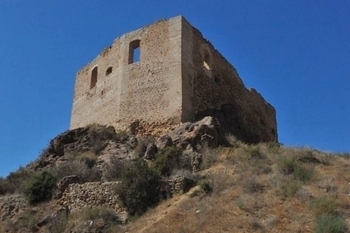 After the Reconquista of Murcia by the Crown of Castilla in 1243 the population fell sharply, and it was not until the Moors were finally expelled that some of its previous vigour was recovered. Mazarrón fell under the control of the Council of Lorca, and life in the town was dominated by the influence of the Marqueses de los Vélez y Villafranca.
After the Reconquista of Murcia by the Crown of Castilla in 1243 the population fell sharply, and it was not until the Moors were finally expelled that some of its previous vigour was recovered. Mazarrón fell under the control of the Council of Lorca, and life in the town was dominated by the influence of the Marqueses de los Vélez y Villafranca.
In the 15th century Enrique IV conceded the ownership and exploitation of the mines to two families, the Fajardos and the Pachecos. The Vélez family built the castle, the ruin of which still towers over the town centre today.
The Marquis of Villena also played an important part in defining the character of the town and surrounding area, each family building their own church, San Antón and San Andrés, both of which still exist today.
At this time there was a widespread increase in the use of alum and ochre throughout Europe in the industries of candle-making, dying cloth, leather, stained glass, medicine and others. This became a key to the continued prosperity of mining in Mazarrón, and at one time the town was known as the "Alum Houses of Almazarrón"
The Independence of Mazarrón
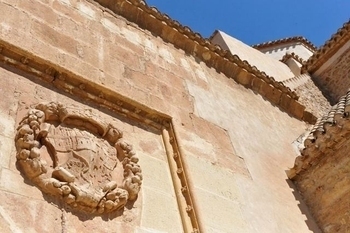 On August 1, 1572, the course of Mazarrón's history altered radically. Felipe II granted the town its own independent status, and the municipality now had its own Town Hall, making its own decisions and governing its own affairs. The coat of arms of the town dates from this time.
On August 1, 1572, the course of Mazarrón's history altered radically. Felipe II granted the town its own independent status, and the municipality now had its own Town Hall, making its own decisions and governing its own affairs. The coat of arms of the town dates from this time.
Mining continued to be the main activity and a certain level of prosperity was achieved.
Pirates!
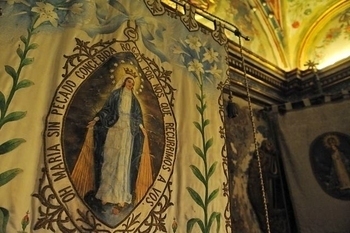 However, insecurity followed in the form of the threat from Berber pirates, which led to watchtowers being built to help defend the town against attacks. The coastline became the first line of defence, as can be seen from the number of towers built, many of which still exist, such as the Torre de Santa Elena in La Azohía, the Torre de los Caballos in Bolnuevo and the Molinete. Most people agree on the Christian origin of the towers, although some claim that they were originally Moorish coastal watchtowers.
However, insecurity followed in the form of the threat from Berber pirates, which led to watchtowers being built to help defend the town against attacks. The coastline became the first line of defence, as can be seen from the number of towers built, many of which still exist, such as the Torre de Santa Elena in La Azohía, the Torre de los Caballos in Bolnuevo and the Molinete. Most people agree on the Christian origin of the towers, although some claim that they were originally Moorish coastal watchtowers.
The danger from the high seas was almost continual at this time and a local legend tells that in 1585, under attack from pirates, the Virgen de la Concepción went down to the beach herself to repel the attacking forces. This is commemorated in the annual Romería of Bolnuevo and the church of La Purísima in Mazarrón contains a scrap of silk said to be the original flag held by the Virgin as she warded off the pirates.
OVer the centuries the prosperity of Mazarrón gradually evaporated, in large part due to competition from mineral mining in other countries. In an attempt to arrest the slide, new mines were opened and economic crisis was kept at bay.
The 19th and 20th centuries brought many changes in the life of the municipality and of those living here as the need to adapt to different circumstances frequently arose. At this point there is still no evidence of the existence of a permanent population in the area now known as Puerto de Mazarrón.
Mazarrón:The Rise of Fishing
 It was not until the 18th century that fishing became a truly significant part of the municipalitys activities, and began to assume the importance it has today. As soon as the Crown, the Merchant Navy and the fishing industry began to encourage the development of fishing as an industry, and at the same time as it became necessary to improve the transport of alum and ochre, it became of paramount importance to build homes and warehouses on the shoreline. However, only in the 19th century did life in Puerto de Mazarrón become significantly independent from that of the town itself.
It was not until the 18th century that fishing became a truly significant part of the municipalitys activities, and began to assume the importance it has today. As soon as the Crown, the Merchant Navy and the fishing industry began to encourage the development of fishing as an industry, and at the same time as it became necessary to improve the transport of alum and ochre, it became of paramount importance to build homes and warehouses on the shoreline. However, only in the 19th century did life in Puerto de Mazarrón become significantly independent from that of the town itself.
The natural riches at the disposal of Mazarrón did not begin and end with alum, and in the 19th century other minerals were extracted, giving the area far more potential. The fishing industry grew hand in hand with the port and the mines, bringing prosperity to the municipality.
Mazarrón: the Golden Age of mining in the 19th Century
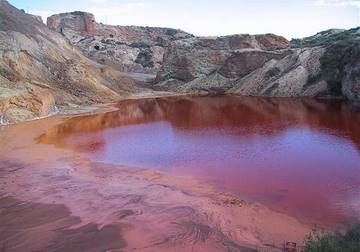 Without doubt the re-birth of the mining industry was the most important contributing factor in Mazarrón's re-emergence, with three mines in particular (Coto San Cristóbal, Coto de Las Pedreras and Coto Fortuna) playing their part. They were now exploited for their wealth in alum, silver and lead, and the municipality became an important player in the mining industry within the Region of Murcia.
Without doubt the re-birth of the mining industry was the most important contributing factor in Mazarrón's re-emergence, with three mines in particular (Coto San Cristóbal, Coto de Las Pedreras and Coto Fortuna) playing their part. They were now exploited for their wealth in alum, silver and lead, and the municipality became an important player in the mining industry within the Region of Murcia.
Of course, such large-scale mining activity demanded smelting facilities to process the minerals extracted and the mining companies were important in the economy of Mazarrón, controlling smelting foundries for years. Mining fever was at its height in the 1840s, and new laws helped the development of the mines until the products of Mazarrón were on sale in the international marketplace.
The wealth in mining led, logically, to better conditions in the area: investment was high, there were many immigrants, and there were soon electric streetlights, a railway track, prestigious buildings and a miners' hospital. The results of this economic resurgence can still be seen in various buildings completed around this time. The old Town Hall (the Casas Consistoriales), built in 1889, is modernist in its architectureand has been declared a National Historic-Artistic Monument. Conditions within the mines, though, remained atrocious.
Apart from mines there was also growth in the esparto grass industry, as well as salt flats and metalworking companies. On the back of these activities, caustic soda and tuna fishing also grew in importance, and not far behind came the first signs of the tourist industry, with the construction of summer houses for important personages who in turn contributed to the prestige and political development of the municipality. Tourism in Mazarrón, though, would have to wait a while yet before assuming the central importance it enjoys today.
Mazarrón: the early 20th century
 The start of the 20th century saw a period of decadence following the exhaustion of the mineral resources in the main mines. The economy contracted and the population frequently went hungry, in line with social and economic developments in the rest of the country. Just as in Spain as a whole there was a bipartite system during the Restoration, in Mazarrón there were frequent changes of Mayor. This crisis is reflected in the population: in the 1900 census there were 23,284 inhabitants, but by 1920 the figure had dropped to 17,630. In this 20-year period people struggled simply to survive and foreign capital left the town, accentuating the crisis.
The start of the 20th century saw a period of decadence following the exhaustion of the mineral resources in the main mines. The economy contracted and the population frequently went hungry, in line with social and economic developments in the rest of the country. Just as in Spain as a whole there was a bipartite system during the Restoration, in Mazarrón there were frequent changes of Mayor. This crisis is reflected in the population: in the 1900 census there were 23,284 inhabitants, but by 1920 the figure had dropped to 17,630. In this 20-year period people struggled simply to survive and foreign capital left the town, accentuating the crisis.
When Mazarrón emerged from this downturn it was by focusing its attention on other areas, more in line with the municipality as we know it today. Attention shifted from mining to agriculture, construction and tourism. The last mine was closed in 1963 and most of the large number of men made redundant left to try their luck elsewhere. Those who chose to stay had to re-invent their ways of life, and many turned their hands to fruit and vegetable farming, where over time Mazarrón's star products became tomatoes, peppers, melons and lettuce, all of which are exported throughout Europe. By the end of the century large areas of the municipality resembled giant greenhouses.
The seasonal migration of the workforce had been a feature of life in the time of the mining boom, and now became an important feature again as workers flocked to earn their living in the seasonal fruit and vegetable industry. Both men and women worked in the fields and the processing plants they spawned, while the growth of tourism from the 1970s onwards also led to an increase in employment within the construction sector.
Large new areas became residential and urbanisations grew up all along the coast. Alongside them was a proliferation of shops, restaurants, bars and leisure activities which met the needs of the tourists in the area, and with the growth of residential tourism from northern European countries in the 21st century this growth increased exponentially.
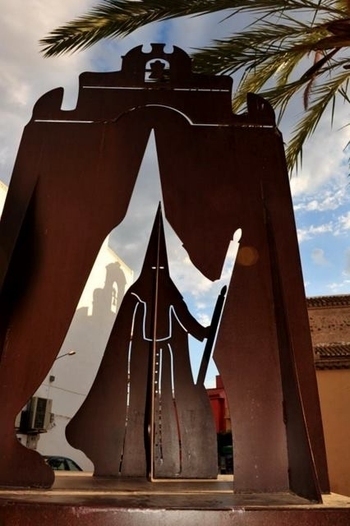 Mazarrón is still an active fishing port, but this is no longer the main area of economic activity in the municipality. The Mazarrón of today is based on strong agricultural production and a vastly expanded tourist sector, both of which bring to the area a large number of people from different areas of Spain and, indeed, the whole world, making it a truly cosmopolitan town all year round.
Mazarrón is still an active fishing port, but this is no longer the main area of economic activity in the municipality. The Mazarrón of today is based on strong agricultural production and a vastly expanded tourist sector, both of which bring to the area a large number of people from different areas of Spain and, indeed, the whole world, making it a truly cosmopolitan town all year round.
Residential development has lead to the creation of urban dwellings and urbanisations and the village of Bolnuevo is now almost unrecognisable from the 1950s as previously open countryside is now packed with residential dwellings.
Urbanisations are also to the fore in Puerto de Mazarron and the Saladillo area (Camposol) which is home all year to an estimated 3,000 ex-pats, with nearly 7,000 homes.
There are now over 31,000 inhabitants in total, compared to only 9,000 fifty years ago, and the improvements in communications, infrastructures and increasingly varied leisure activities available suggest that this figure is likely to continue growing in the decades to come.


